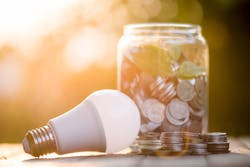Irrespective of one’s political point of view, almost everyone agrees that energy efficiency is one of the easiest and most cost-effective ways to reduce any impact humans are having on the climate, clean the air we breathe, improve the competitiveness of our businesses and reduce energy costs for consumers. Yet, energy efficiency seems to get all the bad breaks. Is it the Rodney Dangerfield of energy options or are we not hearing the whole story?
Energy efficiency’s plight may have begun in the mid-1980’s when compact florescent lights (CFLs) hit the market with retail prices in the range of US$25-35. Even as they improved, CFLs in the 1990’s were still big, bulky, had low light output and inconsistent performance. Nearly 30 years after being introduced, CFLs are finally meeting price and efficiency expectations with energy usage now in the range of 75% less than incandescent bulbs. It will take some time to win folks over, but not everyone has learned this lesson. Some conservationists are upset over a recently announced deferral of the new lighting efficiency standards for a small subset of all light bulbs—specialty decorative lighting. A better option than mandating another less than perfect solution might be to allow competitive pressure among specialty bulb makers advance market options to the point where CFLs or the next-generation light emitting diode (LED) bulbs become the consumer choice and not a mandate.
Misjudgments have left energy efficiency with the short end of the stick in at least one other major instance. Notably, while the tax code is routinely updated to include multi-year tax incentives for renewable energy resources, there are no long-term efficiency incentives; and, at the end of 2017, the remaining tax incentives for homeowner efficiency improvements, new home construction and deductions for commercial buildings expired. The Alliance to Save Energy is calling on Congress to modernize the incentives with updated efficiency thresholds and higher incentives reflecting today's market and performance capabilities. Such a move would acknowledge a fairly well agreed up fact—that buildings use 75% of U.S. electricity and account for 40% of U.S. overall energy use. In addition, the Alliance has testified that energy efficiency is the largest economic sector in the clean energy economy and supports more than 2.3 million jobs.
Is anything going right for energy efficiency? Well, being responsible for 2.3 million jobs and a major economic stake in the growing clean energy market are not chicken feed. Moreover, according to a recent report from Navigant Research, annual energy efficiency spending in North America is expected to reach nearly US$11.3 billion by 2028, indicating this market will continue to grow at a compound annual rate of 4.6% over the next 10 years. In addition, Navigant believes smart energy efficiency players will increasingly add new ingredients in their customer solutions, including energy storage, distributed resources, and, of course, increasingly powerful digital energy management technology. Plus, a growing number of seasoned energy efficiency companies are upping their game with high-quality program financing and administration offerings that are attractive to utilities and other program administrators. Such offerings, which put a new spin on an old game, help offset tight pricing margins, market saturation of energy efficiency technologies in some sectors, and lingering regulatory inconsistency.
No one is more aware that aspects of the energy efficiency market need a continuing infusion of new ideas and solutions than the U.S. department of energy (DOE). Just head to the Office of Energy Efficiency and Renewable Energy website any day to read about energy efficiency research for manufacturing and other industries, leading residential and commercial innovations including loose film insulation advancements, electric heat pump water heaters, improved refrigeration compressors, better windows and more. The Energy Department’s Advanced Research Projects Agency-Energy (ARPA-E) extends beyond energy efficiency by covering game-changing energy technologies of all types that are typically too preliminary for private-sector investment. ARPA-E gets into such areas as data-driven grid management research, medium-voltage electricity power management and more.
The renewed attention to and research regarding energy efficiency is a poignant reminder that there is much more we can do in this area. From promoting (not forcing) better lighting solutions for our customers, providing energy efficiency guidance such as the Updated Energy Savers Guide available for a small cost from the DOE, exploring new company-sponsored efficiency program offerings and even making sure our own houses are in order by putting some extra effort into identifying and reducing system losses, we are making a difference for our customers and the environment. That’s what we call a fair shake!
About the Author
David Shadle
Grid Optimization Editor
Dave joined the T&D World team as the editor of the Grid Optimization Center of Excellence website in January 2016.
Dave is a power industry veteran with a history of leading environmental and development organizations, championing crucial projects, managing major acquisitions and implementing change. Dave is currently a principal at Power Advance, LLC, an independent consulting firm specializing in power project development, research and analysis, due diligence and valuation support. Dave is also a contributing consultant for Transmission & Distribution World. Prior to Power Advance, Dave held business and power project development positions with The Louis Berger Group, Iberdrola Renewables, FPL Energy and General Public Utilities. He is a graduate of Pennsylvania State University, the New Jersey Institute of Technology and Purdue University.
